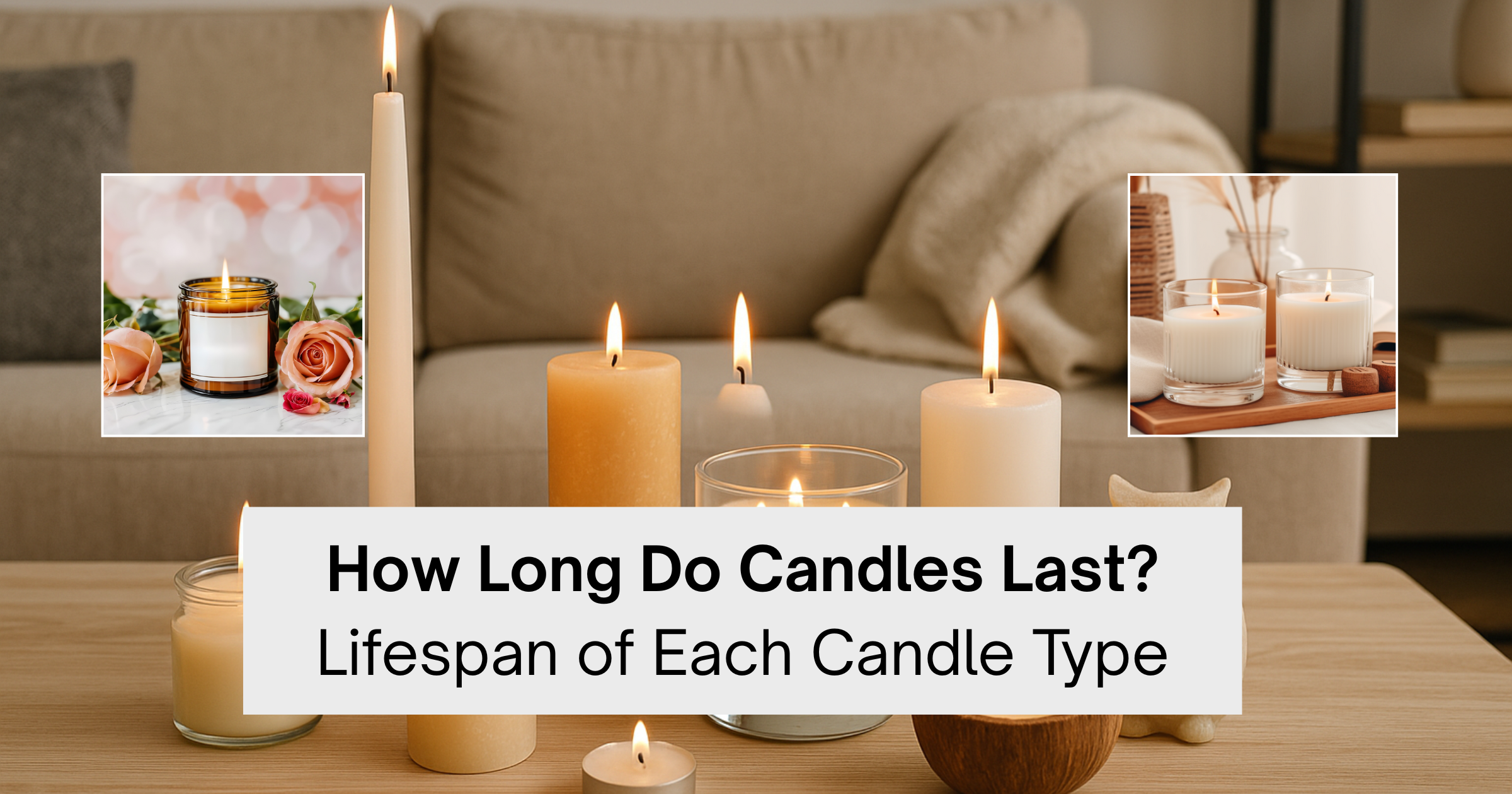How Long Do Candles Last? Lifespan of Each Candle Type

I used to be obsessed with candles. Not just buying them, but hoarding them.
I had a box under my bed labeled “Candle Archive,” full of soy, paraffin, beeswax, and some fancy botanical-infused ones I picked up at a farmers market that, I’ll admit, I never actually used.
One day, while cleaning, I cracked open that box and a thought hit me: Do these things go bad? Like…do candles expire?
Turns out, the answer isn’t as simple as I hoped. And if you’ve ever found yourself wondering how long candles last, then I promise, you’re not alone.
In this guide, I will break down how long each type of candle lasts, from paraffin to beeswax, tealights to decorative ones, and what factors cause them to fade, lose scent, or even grow mold.
Do Candles Expire?
Let me just get this out of the way: candles don’t “expire” in the way milk or medicine does. They won’t suddenly turn toxic or spoil overnight.
But—and this is a big but—they degrade over time. And sometimes, they degrade to the point where they’re useless or burn candles quickly.
Think of a candle as a composite object: it’s wax, fragrance, colorants, and a wick. These parts may seem inert, but they’re all susceptible to time, light, air, and heat.
I’ve had candles that looked fine, but when I lit them… they smelled like cardboard. Others cracked, discolored, or simply wouldn’t stay lit. Not ideal for a cozy evening.
If you’re still asking, “How long does a candle last if I don’t use it?” well, it depends on the type of candle, the ingredients, and how it’s been stored.
Some can last over a decade, others begin to fade after a year.
| Candle Type | Estimated Lifespan |
|---|---|
| Soy Candles | 1–2 years |
| Paraffin Candles | Up to 5 years |
| Beeswax Candles | 5–10+ years |
| 3-Wick Jar Candles | 2–3 years (scented), 5 years (unscented) |
| Scented Candles | 1.5–2 years |
| Unscented Candles | 4–10 years |
| Pillar Candles | 3–5 years |
| Tealight Candles | 1–2 years |
| Novelty & Decorative Candles | Varies widely (1–4 years) |
What Affects a Candle’s Shelf Life?
I hate to sound like a candle snob (I kind of am), but not all candles are created equal.
If you want your candle to stand the test of time, you need to understand what’s behind the label. Here’s what I’ve found matters most.
1. Wax Type
Different types of waxes have different life spans. Here’s the lowdown from my trials:
- Paraffin wax candles: These are chemically stable and can easily last up to 5 years or more, especially if unscented. They’re the Twinkies of the candle world.
- Soy wax: More natural, more temperamental. I’ve had soy candles lose their scent after just 12–18 months. They’re sensitive to heat and tend to sweat if stored improperly.
- Beeswax: Now this one’s a beast. I’ve burned beeswax candles that were 10+ years old and still smelled faintly sweet and burned beautifully. If you want longevity, this is your wax.
- Coconut wax or blends: Luxurious but fragile. Expect a shelf life of around 1–2 years max.
2. Fragrance Oils vs. Essential Oils
Ah, the heartbreaker. Your candle might still look perfect after 3 years, but if the scent is gone—what’s the point?
- Synthetic fragrance oils tend to last longer than essential oils, which oxidize more quickly. A lavender candle might smell lovely at first, but fade into waxy nothingness in under a year.
- Over time, fragrance bonds with the wax and can either weaken or go rancid. Yup, rancid. I once lit an old eucalyptus soy candle and had to open a window within 5 minutes. It smelled like dusty gym socks.
3. Colorants and Aesthetics
Ever pulled out a candle only to find it faded, yellowed, or worse—splotchy and cracked?
That’s the work of time, sunlight, and poor storage. Dyes break down, wax gets brittle, and even the wick can fray.
Candles with dark or vibrant colors tend to show wear more quickly than plain white ones. Ironically, the prettiest ones often age the worst.
4. Storage Conditions
This one’s obvious, but worth repeating. If your candles are:
- Exposed to sunlight
- Stored in warm or humid spaces
- Left unwrapped or uncovered
They’re going to age poorly. Always store them in a cool, dark place, preferably in an airtight container or wrapped in wax paper.
How Long Does Each Type of Candle Last?
In my candle-hoarding journey (yes, I proudly admit to having an entire drawer dedicated to my collection), I’ve learned that a candle’s shelf life hinges on more than just the wax.
The wick, fragrance load, additives, and even the container—it’s all part of the equation. So let’s break it down candle by candle.
1. Soy Candles
Soy candles typically last 1 to 2 years before their scent fades or texture changes.
In my experience, soy candles can start fading within 10 to 14 months, especially those with essential oils.
I once bought a gorgeous lemongrass soy candle from a farmers’ market—it smelled divine at first. By month eight, it had the olfactory excitement of a damp sponge.
They also develop “frosting”, a sort of crystalline bloom on the surface. It’s purely aesthetic, but let’s be honest—if you’re lighting candles for ambiance, cloudy wax isn’t the vibe.
Storage Tip: Keep soy candles in a cool, dark space. And if they’re scented? Burn them sooner rather than later. Time is not their friend.
2. Paraffin Candles
Paraffin candles can last up to 5 years or more, maintaining their structure and fragrance longer than natural wax types.
What I love about them is that they retain fragrance longer than most natural waxes. I’ve stored vanilla paraffin pillars in a linen closet for four years, and when I lit them, they still smelled like Grandma’s kitchen during the holidays.
The downside? That smooth burn often comes with soot and smoke—especially if you don’t trim the wick or burn them near a draft.
Also, floral and citrus fragrances tend to degrade faster in paraffin than warmer, woody notes.
Bottom Line: These are workhorses. If you’re stocking up for emergency candle-making kits or gifting, paraffin gives you breathing room—literally and figuratively.
3. Beeswax Candles
Beeswax candles can last 5 to 10 years or even longer due to their natural stability and resistance to mold.
I found a beeswax taper in an old cabin up north—probably hadn’t seen the light of day in 8–10 years. I lit it expecting disappointment.
Instead? It was glorious. The flame was strong, the burn was clean, and the scent—though faint—was still sweet and warm.
Beeswax has antimicrobial properties and resists mildew, which is rare in organic waxes. It also doesn’t go rancid the way soy or coconut wax can. And because it’s a denser wax, it holds its shape better over time.
Storage Advice: Avoid storing it near strong odors (beeswax absorbs scent easily), and keep it wrapped to prevent dust buildup.
4. 3-Wick Jar Candles
3-wick jar candles generally last 2 to 3 years for the best scent, but unscented ones can be stored for up to 5 years.
These are the celebrities of the candle aisle, right? Flashy, colorful, and—let’s be honest—kind of dramatic. You’ll find them lined up in Bath & Body Works, their triple flames promising full-room aroma.
But here’s the catch: most are heavily fragranced with synthetic oils, and those don’t always age gracefully.
I once opened a sealed 3-wick jar after about 2.5 years in storage. The wax had pulled from the sides of the jar, and the scent? Like wet cardboard pretending to be vanilla.
Also, the glass jars can be moisture traps. I’ve even seen mold form inside one that wasn’t sealed properly (yes—actual mold in a candle).
Pro tip: These perform best when used within 18 to 24 months of purchase. And never store them in your bathroom—it’s a humid city in there.
5. Pillar Candles
Pillar candles generally last 3 to 5 years, especially if made from paraffin or beeswax and stored in a stable environment.
Pillar candles are the rugged outdoor adventurers of the candle world—chunky, strong, and designed to burn for hours without the support of a container.
Typically made from paraffin, beeswax, or blends, they’re less prone to quick degradation than softer waxes like soy or coconut.
But don’t let their size fool you—exposure to sunlight can fade their color and scent over time. If you’ve ever left a red pillar on a windowsill and returned to find it pink and scentless, you know what I mean.
I use pillars mainly for decor during holidays, and I’ve reused some for years without issues—as long as they’re unscented.
6. Taper Candles
Taper candles can last 4 to 8 years if kept in a cool, dark, and dry place, especially when made from beeswax or paraffin.
Tapers are elegant and old-fashioned—the kind you break out during fancy dinners or power outages when you’re feeling dramatic.
Their slim profile means they’re more vulnerable to bending and cracking, especially in warm storage conditions.
Paraffin-based tapers last longer, but if you last longer than soy or beeswax tapers last longer? Use them within a couple of years for the best results.
They’re not built for long-term scent anyway, so if they’re unscented, you’ve got a little more leeway.
7. Tealight Candles
Tealight candles can last 2 to 4 years in storage, though their small size and low wax volume make them more prone to scent loss over time.
Tealights are often overlooked—tiny, cheap, unassuming—but they follow the same rules.
I once bought a bulk pack of 100 candles for Diwali and forgot half of them in the attic. A year later, they had partially melted into each other. Disaster.
The metal or plastic casings can warp over time if stored in fluctuating temperatures, and scented tealights degrade quickly because of the small wax volume.
Buy them fresh. Use them fast.
8. Gel Candles
Gel candles can last up to 2 years, though they are sensitive to heat and may yellow or lose clarity over time.
These are the novelty candles made from a transparent gel-like substance (technically a polymer and mineral oil blend).
They’re often embedded with seashells, glitter, or fruit slices—because why not?
The problem? Fragrance loss happens fast, and the gel can separate or weep over time. I’ve seen old gel candles leak oily residue and even discolor into a cloudy mess.
Great conversation pieces. Terrible for long-term use.
9. Coconut Wax Candles
Coconut wax candles typically last 1 to 2 years, with scent loss and texture changes occurring sooner if improperly stored.
Coconut wax feels luxe—and it is. But it’s also incredibly soft and prone to going rancid if not used quickly. It’s usually blended with soy to give it more structure.
When fresh, these candles have a dreamy, creamy texture and superior scent throw. But over time? They tend to smell “off.” Like… old lotion and regret.
10. Novelty & Decorative Candles
Novelty and decorative candles typically last 1 to 3 years, but intricate designs or additives may shorten their shelf life.
These are often crafted more for visual appeal than burn performance. Think: skull candles, chakra candles, pressed-flower wax art.
They may use fragile waxes, intricate molds, pigments, and essential oils that all degrade at different rates. I treat them like a seasonal item—use, display, or toss within a year or two.
11. Scented vs. Unscented Candles
Scented candles usually last 18 to 24 months before their fragrance begins to degrade noticeably.
Unscented candles can last 3 to 10 years, depending on the wax type, since they don’t rely on fragrance preservation.
How Do You Know If a Candle Has Gone “Bad”?
Sometimes you open a candle and just know—it’s past its prime. But in case it’s not obvious, here are the dead giveaways:
- No scent (cold or burning)
- Discoloration (especially if uneven)
- Cracked wax surface
- Powdery or oily residue on the surface
- Wick looks frayed, bent, or embedded too deeply
- Odd smell when lit (think: waxy, burnt, or sour)
In most cases, an old candle won’t hurt you. But it may not burn evenly, smell pleasant, or perform the way you expect.
Can You Still Use Expired Candles?
Usually, yes—but manage your expectations. You’re probably not going to get that “freshly baked vanilla bean sugar cookie” scent anymore.
It’ll be more like…warm wax with a hint of “used-to-be-nice.”
For decorative purposes or emergency use? Go for it. Just keep a lighter handy and watch for tunneling or uneven burns.
But if you’re hoping for the ambiance of a new candle? You might be disappointed.
How to Make Your Candles Last Longer in Storage
Okay, let’s say you’re like me and you’ve got a little candle hoarding situation. Here’s how to give them the longest possible shelf life:
- Store upright in a dry, cool place
- Avoid sunlight—even indirect light can bleach color and degrade scent
- Use airtight containers or wrap in wax paper + a zip bag
- Keep away from moisture (no bathroom storage!)
- Don’t trim the wick until you’re ready to use it
A candle is kind of like wine: how you store it affects how it performs.
Quick Real-Life Examples
Let me throw a few mini-stories your way:
- I had a peppermint soy candle I kept on my windowsill. After just 6 months, it smelled like nothing. Lesson: Avoid sunlight.
- I inherited a box of vintage paraffin candles from my aunt’s attic—some over 20 years old. Still burned, but the scent? Dusty nostalgia.
- I bought a luxury coconut wax candle that I stored in its original box for 14 months. Opened it, lit it, and boom—still strong, still beautiful.
It’s not just the age. It’s how you treat them.
Final Thoughts
Candles are like relationships—they require a little care, a bit of the right environment, and if you ignore them too long, they may not be the same when you return.
So if you’ve got a stash of candles you’ve been “saving for a special occasion,” consider this your sign: light the damn candle.
Because while some candles might technically last 10 years, the truth is—they’re meant to be enjoyed.
And as someone who once found a 7-year-old vanilla pillar candle that smelled like crayons, I can promise you: sooner is better.
FAQs About Candle Shelf Life
Do candles go bad if unused for years?
They don’t rot, but they do fade. Especially scented ones. You’ll often lose fragrance, and the wax may discolor or become brittle.
Is it safe to burn an old candle?
Generally, yes. Just be cautious of performance issues like poor scent throw or a weak flame.
How long do homemade candles last?
Depends on the ingredients. If you’re using high-quality soy or beeswax with minimal additives, you might get a year or two of scent and much longer of safe burning.
Can I restore an old candle?
Sometimes! If it’s scentless, try melting it down and adding a few drops of essential oil. For a cracked surface, a gentle hairdryer blast can smooth things out. But results vary.
-
Nav Preet is the founder and creative soul behind Karigar Candles. Inspired by heritage, nature, and the warmth of handmade artistry, she crafts candles that do more than glow—they evoke emotion. Through this blog, she shares her love for scents, styling, and mindful living, one flame at a time.
Creative Head at Karigar Style







